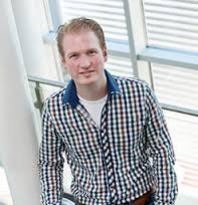Multimodal spectroscopy of single fluorescent nanoprobes
photophysics and characterisation
Promotion date: September 25.
Promotor: Prof.dr.ing. Vinod Subramaniam
Assistant Promotor: Dr. Christian Blum
| Fluorescence microscopy exploits molecular fluorescence as a simple approach to enhance the visual contrast of samples. Beyond their use in fluorescence microscopy, fluorophores have proven to be useful in a much wider range of applications, and across length-scales. For example, fluorophores have enabled probing the direct nanoenvironment of the fluorophores to study chemical processes at the nanoscale. In addition, fluorophores were also found applicable in a diverse range from solar cells and LEDs to sensing, and from diagnostics to quantum computing. For optimum performance, it is important to thoroughly characterize the physico-chemical and photophysical properties of fluorophores prior to use. New fluorescence-based techniques like super-resolution fluorescence microscopy are rapidly developing, and are accompanied by a range of new fluorophores that push the limits of known characterization approaches. Standard ensemble characterization methods give only limited insights into the photophysics of these new fluorophores. Therefore, single molecule characterization methods are required to fully access these photophysical properties of the fluorophores. For this reason, single molecule studies have become very popular over the past three decades. At present, still not all photophysical properties can be accessed at the single emitter level. In my thesis, various techniques and methods are described that we developed to characterize single emitters, and to get detailed insights into the photophysics of quantum emitting systems. |
On which aspects was your research innovative?
Fluorescent microscopy is widely used in biological research, for more than fifty years already. Development of new fluorophores however allows the use of a far wider range of light sources, filtering equipment and detection techniques, allowing: higher resolutions, more contrast in imaging techniques, and studying the cells and molecules individually rather than in bulk environments only.
For me it was a special moment to actually be able to perceive the light emission of one individual molecule and follow its emission trace. This was even the more special if one realizes how volatile the whole set-up is. Stray light can easily spoil an experiment since single molecules exhibit a small photon emission rate. All experimental conditions have to be optimal to allow for single molecule studies.
By monitoring both the emission and absorption components (from the particle) real-time, we were able to sense the nano-environment of the fluorophore. By doing so we were able to tell what the particle actually ‘feels’ from its nano-environment. Be it, for example, the acidity/pH-values, the variations in refractive indices, or the quench channels (i.c. the energy acceptance parameters).
Fluorescence microscopy is at the verge of entering a new period, due to the hypersensitive status of modern equipment prevailing nowadays. I used a basic platform and combined it with a super continuum laser - able to operate throughout the whole color spectrum - and an acoustic optic filter, to make accurate color selections.
By real-time following the Stokes-shift, more chemical conditions in which single molecules operate can be monitored in future. In this way, more research questions topical in this research field can be dealt with.
Another result worthwhile mentioning, concerns the blinking behavior we observed in quantum dots. It appeared these dots can have more stable states as one would expect. We were able to characterize some of them,, nearly inactive but still stable states. This somewhat mysterious behavior may lead to new insights into theoretical debates.
In what way did you develop as a researcher and physician during your PhD period?
Initially, during my master thesis, my work was more theoretical in nature. During the PhD project building up my own experimental set-ups combined with a more practical approach, was prevalent. I learned in what way theory and experimentation could be combined, and to work on the set-ups in a team of experts willing to help and to share their knowledge and expertise. It is good fun to tinker, and to find out more about your own potential in a new field and way of working.
In what magazines were you able to publish your results?
An article was published in Beilstein Journal of Nanotechnology, and in the Journal of Physical Chemistry.
What are your future plans?
Now I am working as an optical engineer at a local company called Focal 2.0, on the design of optical lenses and integrating these in mechatronics products, often combined with computer vision. Custom design and finding technical solutions for practical applications, remains a challenge in which creativity and craftsmanship are required. Optical applications in industry will be asked for in future, I am sure of, especially as this expertise has become less available in recent times.
Did you feel part of the Mesa+ community while working on your PhD topic?
During the annual Mesa+ Days it was very inspiring to get to know the work of renowned speakers from all over the world. Because of the broad scope of the Day it was easy to get into contact with fellow researchers from within Mesa+ as well. During the colloquia I attended some very interesting, more specialized, talks as well.
At Mesa+ one can achieve experimental results in an efficient way as the equipment available is up to date and the freedom to make use of the apparatus is great. The budget to do so is available if one explains the research plans well.
To be able to work at the cleanroom, PhD’s are obliged to follow the courses on a regular basis, which is useful and valuable, but may sometimes lead to some delay in research planning.

